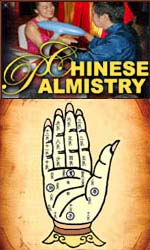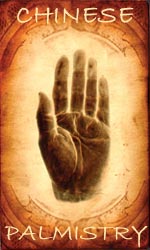

|
APRIL 3, 2009 |
|
|
|
|
|
|
Zhang Qian from Shang Hai handles the yin and yang of TCM palmistry. He says that the palm, the thumb and the fingernails can reveal a lot about the heart, the digestion and the reproductive system. The article presents a short history of Chinese palmistry, the four pilars of TCM (Traditional Chinese Medicine), and an article presented by Zhang Qian in the Shanghai Daily. Traditional Chinese palm reading is deeply rooted in yin yang theory, five phase theory, and the eight trigrams of the Yi Jing (Classic of Change). As far as the written record is concerned, palmistry in China traces its earliest origins to the Zhou Dynasty (1122-770 BCE) when it was then both popular and widespread. The earliest important Chinese discussion of palmistry is found in the Gu Ge Pian (Writings on the Skeleton), also known as Gu Xiang (Appearances on Bones), written by the scholar Wang Chong in the late part of the Han Dynasty (206 BCE-220 CE). According to Wang: Most premodern books on palmistry were not just about palmistry. Rather, sections on palmistry tended to be found as chapters in books on bodily prognostication in general. These books contained sections on face reading or physiognomy (ren xiang) as well as sections on reading one's feet, neck, chest, abdomen, navel, lower and upper backs, weight, stance, and body type. The various signs used as indications in these books were referred to as: xiang. The word xiang in Chinese means 'appearance'. Premodern books typically refer to palmistry as 'shou xiang' (hand appearances) and 'shou zhen' (hand diagnosis). An important school in the history of Chinese palm reading is known as the wu xing pai or 'Five Phase School of Chinese palmistry'. Today one can still find famous monk practitioners of this art in monsteries in the People's Republic of China. Adherents of this five phase system of palmistry believed and still do that appearances in the hand can reveal the san hou or three periods. In other words, one can examine a person's past (xian zhen), the present (zai zhen), and their future (lai zhen). One can also read the hands for information about the four imports or si tong. This means that the appearances of the hands can reveal the mind (xin) or personality, the body (shen), the emotions and thoughts (yi), and the qi which unifies all these three. Thus it is clear that practitioners of this five phase system of Chinese palmistry did diagnose the physical predispositions and ailments of their subjects. Within the last 20-30 years in particular, the medical field has begun to show widespread interest in this system of correspondences. By exploring palmistry from the viewpoint of modern medicine and genetics, further understanding has been gained in the relationship between the lines on the hand and disease. In addition, by utilizing scientific technology, new developments have occurred in the study of palmistry. In China today, biologist, psychologists, and sociologists as well as the above-mentioned anthropologists, geneticists, and physicians are all engaged in substantiating the age-old wisdom on human health and disease contained in Chinese palmistry. An example concerns the work of doctor Wang Chenxia - author of the book: 'Palmar Lines'.
Palm readers claim they can read your future through the heart-line, while traditional Chinese medicine doctors say they can study your palm and learn about the state of your heart, healthwise. The color (pink is healthy), appearance of blue veins and lunula (white crescent at the base of the fingernail) all are indicators of health in TCM. Health problems can show up in your hands, palms and fingernails and if you read the warning signs, you can improve your constitution. But the hands, too, tell the tale, according to Dr Ma Xueling, a TCM folk doctor and author of the best-selling "Wisdom of No Illness" published in 2007. The following presents a few principles described by Dr Ma Xueling: >> HAND COLOR: The color of the palm, says Ma, reveals the general health condition, just like qise of the face. It reflects blood circulation. A healthy palm should be elastic, smooth and light pink. White indicates poor circulation or "pathogenic cold," while red means "pathogenic heat." A dry and wrinkly palm that is either yellow or white color usually is a sign of malnutrition - insufficient energy and blood. If the center of the palm is very white, then pathogenic cold energy has accumulated in your system. Stop eating too much "cold" (yin energy or literally low-temperature) foods. If the center of the palm is red, that means there's excessive yang energy or internal heat. It often goes with a short temper. Eat foods that nourish the cold yin energy while dispelling pathogenic heat, such as white fungus. If the palm is only red occasionally, it may mean you have eating too much reinforcing foods recently, so switch to a plainer diet temporarily. If the thenar (fleshy mass at the base of the thumb) is red, it's usually a sign of excessive internal heat in the head, lungs and heart. It's often a sign of high blood pressure, heart ailments and a bad temper. If the thenar at the little-finger side is red, then there's usually excessive internal heat in the digestive system. It can be a sign of metabolism problems or diabetes. Stretch your palm and keep it still for a while. If the fingers turn darker in color than the palm, or show purple, it may be a sign of serious pathogenic cold. This slows blood circulation and makes the blood thicker. >> VEINS: Blue veins also signify the internal energy. Generally, the fewer blue veins that are visible at the palms and fingers, the better the health. People with several obvious blues veins at the palm and fingers often suffer from constipation. Blue veins in the thumb or middle finger reflect insufficient blood in the head, often causing headache and dizziness. Blue veins at the base of the thumb may indicate hardening of the brain arteries. The thicker the vein, the more severe the problem, in general. Blue veins at the thumb-side of the forefinger indicate a poor digestive system, which leads to weakness and poor immunity. Blue veins at the outside of the little finger indicate insufficient kidney energy. Kidneys also indicate the reproductive and urinary tract systems. People with blue veins at the thenar mass of the thumb have a delicate constitution. They tend to be allergic to certain medicines or foods and tend to get skin ailments like eczema and psoriasis. Blue veins at thenar mass can indicate a heart condition; prominent veins in different areas indicate different conditions, like irregular or weak heartbeat. >> FINGERNAILS: Fingernails, too, can be signals. Healthy nails are pink and smooth with a white lunula, the crescent, at the base of the nail. That's a sign of balanced energy. The thumb and all fingers should have some lunula, more on the thumbnail. If it's only on the thumb, it's a likely sign of excessive yin or cold energy. If there's no lunula at all, that's a sign of bad circulation due to severe pathogenic cold. If the thumbnail lunula is very large, more than a quarter of the jail, there's usually too much internal heat. These people are irritable and short-tempered. Nail ridges are a sign of aging and usually not serious.
Diabetes and belly troubles Press the thenar eminence at the little-finger side area and seek the tender spot; it's usually in the upper third (see: picture 1). Press and rub hard 100-200 times on both hands. Those with chronic digestion problems and intestinal inflammation should perform this massage three times a day. Avoid eating "cold" foods. Gall bladder woes Stomachache troubles some people with gall bladder problems, especially after eating greasy, hard-to-digest foods. In this case, press the upper part of da yu ji (see: picture 2) between the thumb and forefinger. Rubbing hard 100-200 times on each hand can help relieve the pain. Asthma and coughing Ke chuan xue - the coughing and labored breathing point is between the fourth finger and little finger on each hand (see: picture 3). If you feel like coughing but can't get rid of phlegm, press and rub this point to relieve discomfort and make it easy to cough. Press hard against the little finger and rub about 100 times on each hand. |
|
Sources: Shanghaidaily.com, China.org.cn & Healthy.net |
|
|
© COPYRIGHT 2002-2017: |